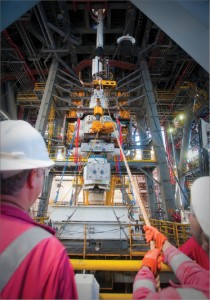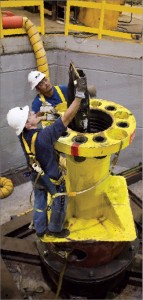Post-Macondo, legislative threats have eased up slightly, but regulatory hurdles still loom large
By Linda Hsieh, managing editor

The deepwater drilling moratorium in the Gulf of Mexico was lifted by US Secretary of the Interior Ken Salazar on 12 October. But is the government truly ready for the industry get back to work, or will this turn out to be just another symbolic gesture?
As 2010 draws to a close and industry considers the approaching new year, perhaps the best way to describe industry’s sentiment in this post-Macondo world is: Hoping for the best but expecting the worst.
On the legislative side, things have actually been looking up since May and June this year. “We were very fearful that Congress was going to hurry into drastic legislation that would attempt to fix something before we even knew what was broken,” said Randall Luthi, president of the National Ocean Industries Association (NOIA).
He credits industry trade groups such as IADC, API, US Oil and Gas, IPAA and NOIA, as well as individual companies, with effecting this change, by contacting Congress en masse with a uniform message: Figure out what went wrong first, then create a targeted response.
“That seems to have worked, and we’re very encouraged,” Mr Luthi said. Nevertheless, several things remain on the agenda in Washington that industry groups are watching closely.
One of the first things Congress will look at is probably increasing taxes or fees on the oil and gas industry. “That’s not a big surprise,” Mr Luthi said. “They’ve made a couple of attempts at it on repealing some of the tax deductions that are currently available to the industry. So far, most senators have heard from their constituents loud and clear, that this is not the time to raise taxes on an industry that is so important to providing jobs in the economy.”
Industry can also expect to see an increase in inspection fees, he pointed out. “But companies already pay royalties. Instead of charging an additional fee for the inspection, that’s where that should be paid from,” he said.
Two significant issues have emerged since Macondo that, according to Mr Luthi, could mean “death by a thousand cuts to the oil and gas industry.” One is doing away with the cap on oil companies’ liability for economic damages resulting from an oil spill, and the other is the issue of financial responsibility.
“Lifting the cap on liability for offshore spills would mean that independents, who represent the majority of companies drilling in the Gulf of Mexico, would not be able to continue… You can’t insure against something like that,” said Brian Petty, IADC executive vice president – government affairs. This provision was included in the CLEAR Act that the US House passed in July.
Although the CLEAR Act was sold as a response to the Macondo spill, the bill itself is actually “a basket of punitive measures designed to hurt the oil and gas industry,” Mr Petty explained. “The people behind it are very hostile to the industry, and the measures are designed to punish.” Another damaging element of the bill, for example, would require an Americanization of offshore facilities, where energy-related vessels will have to be US-flagged.

Good thing that the CLEAR Act has been stymied since it passed the House, and Mr Petty believes that, with a new Congress come January, chances are extremely slim for passing a CLEAR-like bill.
But then there’s still the issue of financial responsibility. Mr Luthi explained that he is concerned Congress will try to substantially raise the requirements operators must meet in terms of their financial capability in case of a spill. An astounding figure of $1.5 billion was mentioned at one point, he said, although Congress has backed off from that. Discussion is now hovering in the range of $300 million.
Whatever the figure ends up being, however, industry believes that its effects must be studied thoroughly before any substantive changes are made. “We’re concerned that a huge increase in the show of financial responsibility would result in fewer and fewer companies being able to actually get out to explore and produce… It’s important to have as many companies as you can out in the Outer Continental Shelf competing with each other. It’s healthy for our nation,” Mr Luthi said.
Finally, industry also faces an increase in fees to be paid into the Oil Spill Liability Trust Fund. This could go from its current $0.08 per barrel to anywhere from $0.48 to $0.78 per barrel, he said. The concern is that Congress may not even use the trust fund for its intended purpose, which is to help pay for spill damage or cleanup. “If you’re going to raise that fee, do it in a responsible and reasonable manner, and use the fund for its intended purpose,” he continued. “It’s the Oil Spill Liability Trust Fund, not the Additional-Tax-On-Oil-To-Pay-For-Other-Federal-Programs Fund.”
THE NEW BOEMRE
Despite the plethora of legislative threats on the horizon, in the short term it may be regulatory obstacles that will really keep the industry from getting back to work. “The biggest danger is going to be the regulations coming out of the BOEMRE,” Mr Petty said, referring to the Bureau of Ocean Energy Management, Regulation and Enforcement. “If they are too onerous and ambiguous, even with the moratorium lifted, companies can’t go back to work. We’re very worried that the agency will impose regulations that it can’t enforce and that it doesn’t have enough personnel and resources to provide oversight,” he said.
IADC has brought this issue up during hearings held by the National Commission on the BP Deepwater Horizon Oil Spill and Offshore Drilling, as well as filed documents with the commission. “In my conversations in Washington, I bring that up over and over,” Mr Petty added.
JITF
Industry certainly has done its part to give the government confidence to allow drilling to resume. Gary Luquette, president of Chevron North America Upstream and chairman of the API Upstream Committee, has been leading the Joint Industry Task Force (JITF) since May. The effort has involved more than 100 companies and 200-plus people.
Within two weeks of the initial blowout, the JITF had set up two task groups, one focused on drilling design and procedures and another focused on BOPs. “We pulled together industry experts from the service sector as well as the operator community … to assess where we were, what we can learn from this blowout, and what we can do as an industry group to improve safety and lower risk,” Mr Luquette said. “We had a great sense of urgency in intersecting the government’s time lines to make sure that we had something in front of them they could consider instead of working in a vacuum. In the end, I think we’ve done a fair job of that.”

He added: “Obviously the expertise for our industry lies within our industry. It doesn’t lie with the regulator. The regulator does not have the depth, the technical understanding and the exposure to the technology that industry has.”
The recommendations drafted by the procedures and equipment task groups were quickly presented to the US Department of Interior (DOI) in May and subsequently adopted in part into the BOEMRE’s Notices to Lessees (NTLs) N05 and N06.
Eventually, the bulk of the recommendations also made its way to the new Drilling Safety Rule announced by the BOEMRE in late September. “Most of what is included in those two documents are things that the joint industry effort pretty much uncovered and recommended to the Interior Department in May,” Mr Luquette said. “It wasn’t much of a surprise to us.”
In late May/early June, the JITF established two additional task groups, this time focused on spill containment and spill response. “As industry watched the difficulties that the incident command at BP was having trying to contain this much oil in a very deepwater, open sea environment, we realized we needed to pull experts back together and focus on the areas of containment and response,” Mr Luquette said. Altogether, the four task groups make up the three-legged stool of prevention, intervention and response.
The oil containment and response groups delivered their recommendations to the DOI in September. Similar to the recommendations delivered by the other two groups, these were structured into deliverables for the short term, the mid-term and the long term. “It’s been well-received by the government. They are keenly interested in adopting it and putting it into place,” Mr Luquette said. “We think we will eventually see notices to lessees that will address oil spill response plans and capability, and that’s where some of the industry recommendations will be promulgated.”
Although Mr Luquette is optimistic that industry could return to deepwater drilling by the end of 2010, there are still potential bumps in the road, one of which is NTL N06. Industry has brought their concerns to the BOEMRE’s attention, but the situation still lacks clarity. A part of the confusion stems from the debate on how to determine worst-case discharge parameters under NTL N06. Industry hopes government will take geologic and mechanical parameters into consideration, as well as the enhanced containment and surface response capabilities that will be in place. A number that is unrealistically high will present unrealistic challenges, he said.
On top of these uncertainties, government red tape will make the processing of permits under NTL N06 even harder, IADC’s Mr Petty added. “Bureaucrats at the BOEMRE have admitted that they don’t really sometimes know when and how you can comply… What used to be decisions made in the field and quickly are now being kicked up to Washington, where it’s like walking in molasses. They’re not getting the answers and guidance they need. It’s a regulatory impasse that is making it very difficult for companies, especially in the shallow water right now, to get back to work,” Mr Petty said.
IN THE LONG RUN
In addition to the near-term uncertainty, the long-term outlook for the Gulf of Mexico is full of question marks as well.
Just before the Macondo blowout, the Obama Administration had talked of opening up new offshore areas to exploration, including parts of the Southeastern US, the Eastern Gulf of Mexico and parts of Alaska. Since Macondo, not only is that off the table, but scheduled lease sales offshore Virginia and Alaska were canceled as well. In fact, there’s been little talk about the 2012-2017 five-year OCS plan at all – and that worries NOIA’s Mr Luthi.
“It takes a period of time to put that plan in place,” he said, including public review periods, comment periods, time for analysis, etc. “Frankly, we fear that the administration is running out of time to complete the new five-year plan before the existing plan expires. If that happens, that would mean there aren’t any lease sales, and that’s really the first step in the whole exploration and development process… We fear the government is concentrating so much on things like increasing inspections and redoing oil spill response plans, they’re not devoting the same number of resources to getting the process up and running for the future.”
For companies trying to make long-term strategic plans for operating in the Gulf of Mexico, this creates very murky waters. Mr Luthi commented: “Eventually we’re going to pay the price because those companies that are able to move to other areas of the world are going to do that.”




